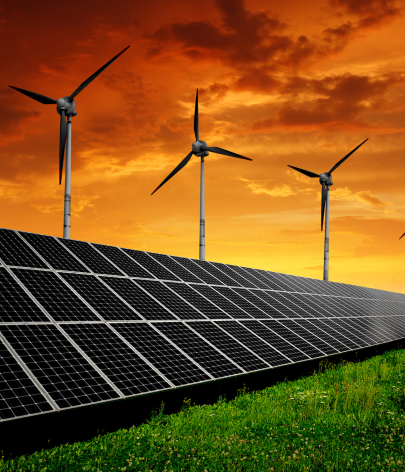Highlights
+43%
Average annual growth in ASEAN’s solar and wind generation between 2015 and 2022
4.1 TWh
Year-on year increase in wind generation across ASEAN from 2021 to 2022
229 GW
Additional solar and wind capacity needed across Southeast Asia by 2030 to align with IEA’s 2050 net zero scenario
About
This report tracks solar and wind generation in ASEAN between 2015 and 2022, and analyses the additional capacity needed by 2030 to align with the International Energy Agency (IEA)’s 2050 Net Zero Emission (NZE) scenario. It is to be noted that the growth of other renewables is equally important for ASEAN countries, but this report mainly explores the dynamics within several ASEAN countries’ power sector’s regulatory environment to engender solar and wind power growth in those countries. The report focuses on Indonesia, Malaysia, the Philippines, Thailand, and Viet Nam, considering these countries as key players in the region’s total electricity generation, in order to formulate feasible recommendations.
Executive summary
Stronger policy measures needed to accelerate solar and wind growth
ASEAN countries are seeing increasing solar and wind generation as they shift towards clean power, but to get on track with the IEA’s 2050 net zero scenario, 164 GW of solar and 65 GW of wind need to be installed by 2030.
Beni Suryadi Manager of Sustainable and Renewable Energy, ASEAN Centre for Energy (ACE)
Rapid power demand growth in ASEAN countries has released market opportunities for the large-scale development of solar and wind powers. Most of the ASEAN countries have updated their national power development plans and strategies that target to have more solar and wind in the mix and put the efforts to create the right environment to mobilise finance, absorb the technology and increase the readiness of the grid infrastructure. Combined with the other renewable energy sources for baseload generation, tapping the true potential of solar and wind will bring the region to go beyond its current target on renewable energy as needed to accelerate the efforts toward net zero.

Solar and wind trends
Tracking the state of solar and wind growth in ASEAN
ASEAN power generation from solar and wind increased by 15% (+6.4 TWh) between 2021 and 2022, a slowdown compared with a 67% (+18 TWh) increase from a year earlier.
Policy outlook
Policy developments and opportunities
Driving up solar and wind generation remains possible due to the falling prices of clean energy technologies, though addressing key barriers to their deployment is now critical for ramping up the build rate.
In this chapter:
Viet Nam recorded the largest growth of wind (+8 TWh) and solar (+26 TWh) generation among other ASEAN countries between 2015 and 2022.
An enabling domestic policy environment accounts for Viet Nam’s solar boom in recent years. Firstly, the Feed-in Tariffs (FiT) that were offered between 6.67 cents USD/kWh and 10.87 cents USD/kWh in 2017, served as an effective scheme to create the renewables market as costs became competitive compared to fossil based generation. Secondly, the government offered land lease exemptions for solar projects that were made possible through good coordination between national and provincial authorities. Thirdly, Viet Nam does not impose local content requirements on renewables projects that make them an attractive market for foreign investors. Lastly, tax exemption for renewable equipment helped improve RE competitiveness.
Prime Minister’s Decision 13/2020/QD-TTg on Feed-in Tariffs (FiT) also offers incentives for the adoption of rooftop solar PV, enabling households to sell surplus electricity to the state-owned EVN and its subsidiaries for 20 years at a rate of 8.38 cents USD/kWh. Additionally, this revenue below 4000 USD is exempt from personal income tax.
In 2023, Viet Nam approved the National Power Development Plan (PDP) VIII for the period of 2021-2030, outlining specific targets of adding 12.8 GW solar capacity (excluding existing rooftop solar power) by 2030, reaching 168-189 GW by 2050. Given that the installed rooftop solar PV capacity was 9.3 GW in 2021, the target for solar power plants by 2030 is set to reach around 22 GW. The wind capacity target is more ambitious, adding 28 GW (onshore and offshore) by 2030 and 130-169 GW by 2050.
Discussion
Changing the supply and demand equation
Economic growth is necessary – renewables can now power it.
It seems quite optimistic to assume that ASEAN will have a net zero power sector by 2040 with the current rate of renewable growth. Last year, ASEAN emitted 5% of the world’s coal power emissions totalling 402 million tonnes of CO2. With that caveat, it presents a challenging compromise between the pursuit of economic growth and the imperatives of addressing climate change. This does not imply that ASEAN countries should abandon economic growth altogether but rather that they should find ways to promote production powered by renewable sources.
Harnessing solar and wind potential depends on the countries’ strategies to address barriers on the supply side and implement measures to create demand for renewable energy. On the supply side, governments should focus on policies that are able to support an efficient supply chain of renewable energy technologies, increase capital investments and establish the local renewable energy industry. Regulatory barriers such as local content requirements must be removed and fiscal incentives should be introduced to further grow the domestic industry. In addition, increasing grid flexibility and investment in grid infrastructure and grid-based storage are necessary to address curtailment issues hindering the growth of renewable energy, as shown in Viet Nam.
On the demand side, mandating renewable portfolio standards, introducing subsidies for renewable energy producers, providing a green electricity tariff and streamlining the permitting process for renewable energy projects are some of the options that can incentivise renewable energy providers, thereby driving the demand for renewables. Establishing special economic zones fully powered by renewables is helpful for attracting businesses, particularly RE100 companies that procure renewable electricity at scale. Considering that industries accounted for 39% of total final energy consumption in 2020, this move will help boost demand for renewable energy.
Conclusion
Solar and wind can unlock clean transportation - and beyond
Solar and wind led to new opportunities to bolster ASEAN’s preparedness for the electrification of the transportation sector
In September 2023, leaders of ASEAN +3 (which includes China, Japan and the Republic of Korea) issued a statement underscoring their shared commitment to a just energy transition and the reduction of carbon emission reduction in the transport sector, acknowledging its impact on economic growth. This statement further emphasises their earlier declaration from the 42nd ASEAN Summit, which focused on the development of the regional electric vehicle ecosystem.
With this trend in mind, there is an increasing urgency to transition towards clean power generation, particularly as the widespread adoption of electric vehicles is expected to significantly raise electricity demand. Integrating electric vehicle charging infrastructure with a cleaner power grid will contribute to a more sustainable and low-carbon energy system.
Solar and wind may lead to new opportunities to further equip ASEAN for the development of such charging infrastructure. In addition to being a cleaner option, solar and wind are getting cheaper worldwide. To adequately capture these falling prices in the region, revamping the power market could create incentives to leverage the deployment scale and create more efficient supply chains for both energy sources, thus improving the investment climate.
To be on track for IEA’s 2050 net zero scenario, ASEAN countries need to foster an enabling policy and regulatory framework, ensuring the implementation of attractive renewable pricing mechanisms and efficient renewable supply chains. Additionally, policymakers in ASEAN should invest in grid modernization and flexibility measures to ensure the secure and cost-effective integration of solar and wind technologies into the power grid.
Lastly, in the short term, the relaxation of local content requirements may be necessary to enhance renewables’ competitiveness against conventional generation, particularly until the local renewable manufacturing industry is fully established in ASEAN countries.
As a rapidly growing economy, transitioning to cleaner energy sources, and accelerating solar and wind growth, is vital for ASEAN to reduce carbon pollution in the coming years and position itself at the forefront of the new clean energy economy that is rapidly emerging worldwide.
Supporting Material
Methodology
Capacity additions calculations for IEA 2050 Net Zero Emission (NZE) scenario
For this report, we calculate capacity additions required in Southeast Asia to meet the combined wind and solar share target of 23% by 2030, set out in the IEA NZE scenario. We estimate the required electricity generation by 2030, using ASEAN Centre for Energy (ACE) average annual electricity growth rate projection of 5.8%. Then, we estimated the amount of solar and wind capacities that need to be installed to reach the IEA NZE share target, by assuming capacity factors of 16% and 28% for solar and wind, respectively.
Capacity additions calculations for ACE’s scenario
ACE Least-Cost Optimisation scenario (LCO) is a technology-neutral optimisation scenario applied to the power sector, considering the cost-effectiveness, and maturity of technology to fulfil growing electricity demand, including the deployment of energy storage and interconnection.
Scope of study
The policy discussion in this report focuses on five ASEAN countries, which dominate the total electricity generation in ASEAN and thus, significantly contribute to the region’s emissions reductions. However, contributions from Singapore, Myanmar, Lao PDR, Cambodia and Brunei Darussalam are equally important for the region to achieve their climate goals.
Data set
The data set for each chart is available for download.
Acknowledgements
With thanks to Beni Suryadi from ASEAN Centre for Energy for his quotes. The contributions of Richard Black, Aditya Lolla, and Pamela Simamora in peer-reviewing, along with the key roles played by Matt Ewen, Oya Zaimoglu, and Uni Lee in data validation, and the invaluable efforts of Chelsea Bruce-Lockhard and Reynaldo Dizon in data visualisation have significantly shaped the final outcome of this work. Hannah Broadbent and Ardhi Arsala Rahmani’s editing and structural enhancements were also crucial in the development of this report.
Header imageSolar PV and wind turbines in Phan Rang, Ninh Thuan, Vietnam.
Credit: Quang Ngoc Nguyen / Alamy Stock Photo





